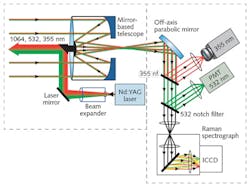Photonics in Space: Laser-based remote sensor will probe other worlds in multiple ways

Spectroscopy has been key to the exploration of the Solar System. Spectroscopic instruments that have flown on various space missions include the ChemCam, which is part of the National Aeronautics and Space Administration's (NASA's) Curiosity rover now exploring Mars and includes a laser-induced breakdown spectroscopy (LIBS) instrument; UV, visible, and infrared (IR) spectrometers aboard the European Space Agency's (ESA's) Rosetta spacecraft, which has been orbiting and examining the comet 67P/Churyumov-Gerasimenko since January 2014; and the ALICE spectrometer, part of NASA's LCROSS mission, which confirmed the presence of water on the Moon. Also, an improved ChemCam called the SuperCam will be part of NASA's Mars 2020 rover mission. The SuperCam will contain Raman and time-resolved fluorescence spectroscopic instrumentation.
However, each of the spectroscopic systems for these missions was designed and built from the ground up as a unique creation. What if a single instrument could be designed for use on many different types of missions, combining a variety of different spectroscopic approaches? While adaptations for a particular mission might be necessary, such an instrument would greatly reduce the time and expense of designing unique hardware for each mission.
A group of researchers from the NASA Langley Research Center (Hampton, VA), the NASA Ames Research Center (Moffett Field, CA), and the University of Hawaii (Honolulu, HI) have created such an instrument: a multispectral device that includes Raman, laser-induced fluorescence (LIF), LIBS, and light detection and ranging (lidar).1 The instrument can perform Raman and fluorescence spectroscopy to distances of greater than 100 m and can do lidar-based single-wavelength atmospheric profiling over ranges of greater than 20 km. The unit is designed for anticipated missions to Mars and Jupiter's icy moons, but is capable of investigations of comets and asteroids as well as other planets in the Solar System.
Looking at ground and sky
The instrument is based on a space-qualifiable Nd:YAG laser source from Fibertek (Herndon, VA) that produces the fundamental, frequency-doubled, and frequency-tripled wavelengths of 1064, 532, and 355 nm, respectively, emitting 45 mJ pulses at a 20 Hz repetition rate. The laser light is sent outward via a small mirror at the center of a telescope with a 10.16 cm aperture (see figure). Return light is collected by the telescope and spectrally split so that the 355 nm fluorescence excitation light is dumped, part of the 532 nm light is sent to a photomultiplier tube (PMT) for lidar, and the rest of the light is available for other instruments (with the 1064 nm light dumped if not needed).
A compact grating spectrograph designed and built at the NASA Langley Research Center contains a miniature intensified CCD (iCCD) camera and detects signals in the 530–700 nm spectral range. The prototype is designed for rover-mounted remote sensing applications that detect surface-backscatter signals as well as upward- and horizontal-looking return signals. In use, the laser beam points at the ground for Raman fluorescence detection and at the atmosphere for lidar profiling.
Experimental tests on the lidar system in one run at Langley showed successful profiling of aerosols and multilayer clouds at altitudes between 0 and 10 km, detecting cloud layers at 9, 5.5, 3.5, and 1.5–2 km altitudes. Averaging over 1200 shots (1 min) was done to reduce noise.
The compact remote Raman system is experimentally able to identify water, ice, and carbon-dioxide ice at a 50 m distance and with a 10 s integration time using 532 nm laser excitation. Both forms of ice are known to exist on Mars; water in liquid form could perhaps be found on Mars in briny form someday. In addition, Europa and certain other outer Solar System moons have underground oceans of water. The Raman system experimentally determined many other substances as well, such as hydrated sulfate minerals and quartz.
A LIBS system was also tested, successfully identifying different elements in lava rock. Also, a LIF system was tested on rocks that were potential Martian analogs; the system detected successfully biogenic materials in or on the rocks. In combination, the components that make up NASA's prototype multispectral instrument allow a broad selection of chemical, geological, and biological tests that are well suited for scientific exploration of the Solar System.
REFERENCE
1. M. Nurul Abedin et al., Appl. Opt. (2015); http://dx.doi.org/10.1364/AO.54.007598.
About the Author
John Wallace
Senior Technical Editor (1998-2022)
John Wallace was with Laser Focus World for nearly 25 years, retiring in late June 2022. He obtained a bachelor's degree in mechanical engineering and physics at Rutgers University and a master's in optical engineering at the University of Rochester. Before becoming an editor, John worked as an engineer at RCA, Exxon, Eastman Kodak, and GCA Corporation.
